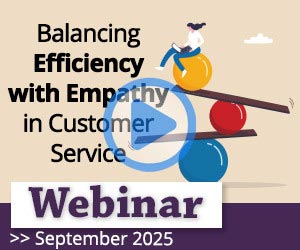We provide our advice for training advisors to use empathy in the contact centre, before sharing some activities that will help you to develop empathy skills further.
Firstly, Assess Emotional Intelligence in Recruitment
To be a contact centre advisor, you need certain skills that are difficult to test in conventional one-to-one interviews. One of the skills is Emotional Intelligence.
Emotional Intelligence is the skill behind empathy. While anyone can show empathy through acknowledging the customer’s issue, taking ownership of the customer’s problem and offering reassurance, only someone with high Emotional Intelligence will know how much of each is required, for each customer.
Jacqui Turner, the Founder of Turner Corner Learning Solutions, says: “It’s important to get a sense of how people react in certain situations, as ideally you want to find candidates who have the capability to reassure the customer and recognise the right actions that need to be taken, instead of just understanding their problem.”
How can you do this? Try using recruitment days whereby you introduce potential advisors to the contact centre before running activities and starting a conversation or two where empathy is required. How recruits react in these scenarios will give you a hint of their natural empathy levels.
DPD are one company which offers recruitment days. To find out more about their contact centre, read our article: 15 Things You Can Learn From the DPD Contact Centre
Show Advisors What Good Looks Like
Once you have recruited your new team of emotionally intelligent advisors, you should now show them what good empathy looks like in the contact centre, and that can be done well through group quality analysis sessions.

Jacqui recommends: “Find call recordings of three or four great customer–advisor conversations, with different types of customers who show different emotions during their calls.”
“Then get the advisors to think about what they would want from the advisor, if the customer was in fact a close friend or family member of theirs.”
While this gives advisors an opportunity to practise reading a customer’s emotional signals and adapting their approach accordingly, it allows them to understand the key ingredients of showing empathy for themselves. These include:
- Active listening and asking respectful questions to understand the full extent of this issue
- Acknowledging how the customer feels (now you know the full details)
- Reassuring the customer that you will help to resolve the issue
- Taking ownership of the issue / taking the burden away from the customer
- Providing a sense of immediacy
- Making a commitment to the customer
While through your QA sessions you might find even more ingredients of empathy, these are key parts of demonstrating empathy and the call recordings will have shown the new recruits how to use each one well.
This is much better than just giving advisors a long list of empathy statements to repeat back to customers. Although these can still be useful as guidelines if an advisor loses their way during a tricky call.
Finally, it can also be good to play examples of when an advisor has used empathy incorrectly in QA sessions, as long as the identity of the advisor who originally took the call remains anonymous.
For example, you could find a recording where the customer has become upset when the advisor says that they “understand”, before the customer has revealed the entirety of their issue – so how could they understand? This will help the new recruits to avoid repeating the same mistakes.
For a full list of empathy statements, read our article: 18 Empathy Statements That Help Improve Customer-Agent Rapport
Role Play Scenarios Where Empathy Is Essential
To ensure advisors are comfortable in communicating empathy, it is good to role play various situations to be better prepared for taking to the contact centre floor.
However, when it comes to role playing, contact centres often get it wrong, as it’s quite common to randomly select two people and have them “act out” the scenario in front of the rest of the group.
Jacqui feels this approach isn’t always the best approach, stating: “It works with some people, particularly extroverts, but some can find it uncomfortable to do something that they haven’t done before in front of a large group of people that they do not know.”
“Plus, if you get two shy, disengaged recruits, the rest of the team will switch off and the learning will stop. It’s best to keep everybody involved.”
With this in mind, it is better to split the team into groups of three, where one plays the advisor, one the customer and the final advisor plays the observer.
The customer and the advisor would then interact as they would on the phone, after being given a business-specific situation.
The observer will then report back to the group to comment on what they thought the advisor did well and what they would have done differently.
Better still, bring in actors to pretend to be the customer, if you have the budget to do so. This, according to Jacqui, “will be much more memorable, while it also gives new advisors the closest possible representation of what it’s like to handle calls and show genuine empathy.”
Ask Advisors to Think About Their Own Triggers
When advisors get into a routine of taking contact after contact, it can become difficult to consistently show high levels of empathy. As this happens, it is common for advisors to slip into habits that undermine their attempts of showing empathy.
One common habit is to use trigger-words, which customers despise but often just slip off the tongue.
Take the word “fine” as an example. While many people will take it at face value, in certain contexts it can be considered passive-aggressive.
Another example would be “sorry for the inconvenience”, because you – as the advisor – have heard their problem and know exactly what the “inconvenience” was. So reflect that back to them and ensure the customer knows that you’ve fully understood their troubles.
Other words and phrases that can really undermine empathy are highlighted in the table below, with a set of better alternatives alongside them.
| Instead of… | Say… |
|---|---|
| “…but…” | “…and…” |
| “You need to…” | “I suggest that you…” |
| “You said…” | “As we previously discussed…” |
| “Don’t reject…” | “If you accept…” |
| “Calm down…” | “We can get to the bottom of this, if we discuss it calmly with one another…” |
| “I don’t know…” | “Let me find out…” |
To help advisors to avoid using these words and phrases, Jacqui recommends: “Try discussing customer service mistakes in a group and create a list together.”
“Start by giving a couple of your own examples and gather suggestions from the group. This may get them speaking about bugbears which they can bond over, as they show their passion for the issues.”
“With this passion, they’ll be more likely to avoid making the same mistakes, especially if you can provide better alternatives.”
“You could also use ‘mentimeter’, which is a presentation tool that enables enables teams to enter their responses to questions via their mobile with the reassurance that the information is anonymous.”
“I’ve tried this in a recent training session and the group provided very honest responses without fear they would be judged by the group. They loved using their mobiles too!”
To access a poster with the top phrases for customer service, click here.
However, it’s not all about words and phrases, you should also consider other things like tone, as an advisor can say all of the right things, but their tone could indicate that their empathy lacks sincerity.
If you come across examples where an advisor’s tone may be problematic, play those calls back to them, so that they get an idea of what they sound like. Being aware of the problem is the first stage of combating it.
While these techniques help the team to avoid pitfalls in showing empathy, it is also good for the team leader to have quick “trigger conversations” with advisors after every few calls. This just helps to remind advisors of their purpose, to focus on the individual needs of the customer.
Find out more about trigger conversations in our article: 10 Great Conversations to Have With Your Contact Centre Team
Teach the Team to Be Empathetic With One Another
To show natural empathy, it’s important to become accustomed to showing it in everyday life, and that will extend into the contact centre.
As Jacqui says: “It’s easier to develop an understanding of empathy with the people that you interact with on a daily basis. So it’s good to develop the necessary skills internally, and that will begin to naturally flow through to customers.”
To do this, you must lead by example and use the techniques that you coach advisors to use on the phone in your daily conversation. These techniques include:
Reflect Back the Other Person’s Words – When a colleague says that they feel a certain negative emotion, tell them that you’re sorry that they’re feeling the emotion that they expressed. Be compassionate, offer reassurance and then discuss possible solutions.
Acknowledge Other Perspectives – When someone expresses a view that is different from your own, don’t reject it. Instead, acknowledge it. This does not necessarily mean agreement, but showing that you can accept views that are different from your own shows that you are capable of empathising with everyone.
Avoid Assumptions – When we make assumptions, we rush into conclusions. Customers often want to tell us the full extent of their problem and be empathised with, so when we make assumptions we can deprive them of this opportunity. To be empathetic, we must be attentive.
Rethink Your Attitude – Re-evaluate your “routine” day in the contact centre. When was the last time that you showed an advisor that you cared for their well-being? There is great value in doing simple things like having off-the-cuff conversations with team members to find out more about them.
3 More Training Exercises
We have already discussed three great coaching exercises to improve empathy skills; group QA sessions, role play and “bugbear” conversations. However, there are many more for you to try.
With this in mind, here are three more training exercises that we hope will help to improve your advisors’ empathy skills. The first is recommended by Jacqui, while two and three were shared with us by Caroline Cooper, a Trainer and Consultant at Naturally Loyal.
Exercise 1: The Wrong Response
Split into pairs or groups of three and provide each group with the following scenario.
You’re having a bad day: your computer crashed causing you to lose the entire report you’ve been working on for three days (and forgot to save).
The report is due tomorrow and you have to rewrite the whole thing tonight. Your car broke down on the motorway this morning, and you had to wait three hours for the tow.
And now it can’t be fixed for three days while they get the parts. You’d really like to replace this old junk, but you can’t afford to because of the amount you’re spending on the room addition for the new baby. It’s all too much.
You say to your colleagues:
“I’ve had it. I just can’t take it any more. My PC crashed. I lost my big report and it’s due tomorrow. I just sat on the side of the road for three hours.
My car is going to cost me a bundle to fix and I really need a new one but I have no money because we’re building an addition to the house. I need a holiday.”
Having heard you say this; your colleagues make the following statements:
- I need a holiday too.
- Sounds like you’re spending a lot of money.
- If you need a new car my neighbour just bought the new FIAT and loves it.
- When is that report due?
- Sounds like you’ve had a rough time of it today.
Ask your groups of three to consider each response, by asking them to answer each of the following questions in regard to each comment:
- How would this response make you feel?
- What about this response feels appropriate/inappropriate?
- How would you respond to this response? Will your response depend on the historic relationship you have with this person?
- What did this person hear/not hear in relation to what you said?
- What did this person add/subtract from your words that led to their response?
You will likely collect lots of negative comments about each of the comments apart from “sounds like you’ve had a rough time of it today”.
In this comment there’s no judgement, triggers, assumptions, misunderstanding, or bias. The receiver heard the meta-message: you were having a bad day, rather than just listening to one part of the conversation, such as the car. And he’s offering empathy.
Key Take-Aways
- We understand that everyone has emotional needs as well as functional needs
- We recognise that there may be things that customers aren’t telling us
- We realise that we have to listen actively and ask respectful probing questions to show real empathy
Exercise 2: Best Mate
This is a fun activity to demonstrate the power of being enthusiastic and welcoming towards customers.
Ask the team to stand up. Now they are to imagine…
You are walking down the street and see coming towards you someone you really don’t want to chat to as you know they’re the most boring person on earth, and you have a hangover, and this person is really the last person you want to speak to! Be polite, but nothing more.
Say hello to as many people as possible in 30 seconds, imagining they are all these boring people!
Now greet as many people as you can, this time imaging they are your best mate and you haven’t seen them in six months! You have 45–60 seconds to greet as many people as possible.
Warning: This can be a fun activity but also when done well can be very noisy!
Allow the group to let their hair down.

So if you imagine your energy levels on a scale of one to ten, with the first example being at a one and a second example being at a ten, where do you want to be on that scale when you’re connecting with customers?
Sum up by stating how our behaviours and tone impact how we are perceived and in turn how welcome a customer will feel. So put some energy into your greetings with customers.
Discuss how we may not need to be at a ten, but it needs to be nearer ten than one.
Key Take-Aways
- We can only show genuine empathy if our tone and behaviours indicate that we have genuine interest in the other person
- We feel much better when we are greeted by a positive person
- We can improve our customer conversations by being aware of the attitude in which we approach calls
Exercise 3: Questions and Answers
This game involves asking advisors two questions, to test their listening abilities – although they should not be told that this is the intention of the exercise.
The two questions to ask the team are:
- How many of each species did Moses take into the ark?
- You are driving a bus which leaves Stoke at 8.30 with 23 people on board. It stops in Leicester dropping off ten and picking up a further four passengers. It travels further south to Milton Keynes, where it drops off another five passengers and picks up a further six. It arrives in London two hours later. What was the driver’s name?
These questions seem simple to answer, right? Yet, in Caroline’s experience, advisors nearly always get both of these questions wrong.
The right answers are:
- None, it was Noah
- You
So, why do advisors nearly always answer these questions incorrectly. Caroline says it’s because:
- We hear what we expect to hear so we assumed it was Noah
- We don’t always catch the most important part of the question and get side-tracked with irrelevant information.
Key Take-Aways
- When we make assumptions, we do not truly listen to the customer’s problem
- We must check our understanding to show true empathy
This final exercise was originally put forward by Caroline in our article: 9 Fun Customer Service Training Exercises
In Summary
The first step in increasing empathy levels in the contact centre is to look out for Emotional Intelligence skills in recruitment. This will make the coaching process much easier.
Then, use techniques such as group QA sessions to give advisors a sense of what good looks like and support advisors in role-play scenarios, to develop their individual empathy skills.
To grow these skills further, make sure the contact centre is a harmonious working environment, where people are empathetic with one another – so managers and team leaders should lead by example.
Finally, there are a number of other activities that you can use to continuously coach empathy in the contact centre, which go beyond conventional one-to-one training. The three example exercises in this article each contain key learning that will hopefully stay with your team.
To find out more about how you can nurture your team’s empathy skills, read our articles:
- How to Improve Empathy in the Call Centre
- How to Support Employees Handling in Emotionally Challenging Calls – With Empathy
- Dealing With Angry Customers
- How to Train Active Listening in the Contact Centre – With Four Exercises
- 7 Games to Liven Up the Contact Centre
Author: Robyn Coppell
Reviewed by: Megan Jones
Published On: 11th Apr 2022 - Last modified: 6th Jan 2026
Read more about - Skills, Caroline Cooper, Editor's Picks, Empathy, Jacqui Turner, Jacqui Workman, Language, Skill Development, Soft Skills, Training and Coaching







































